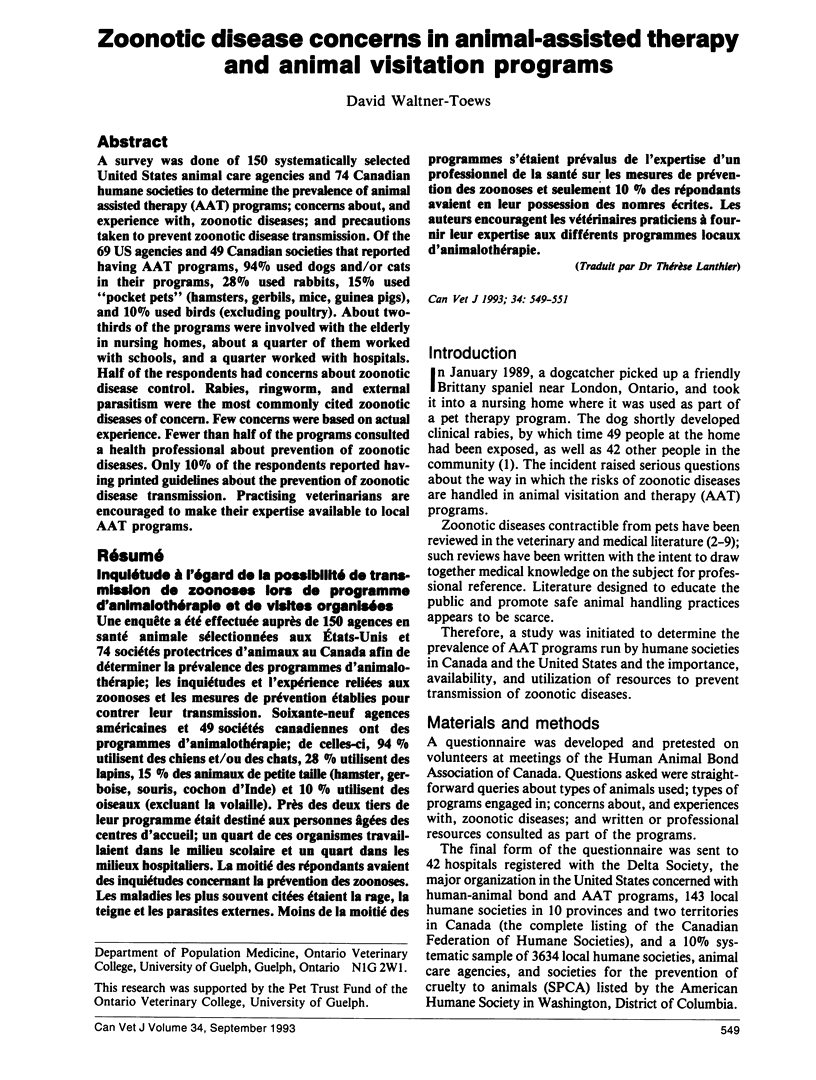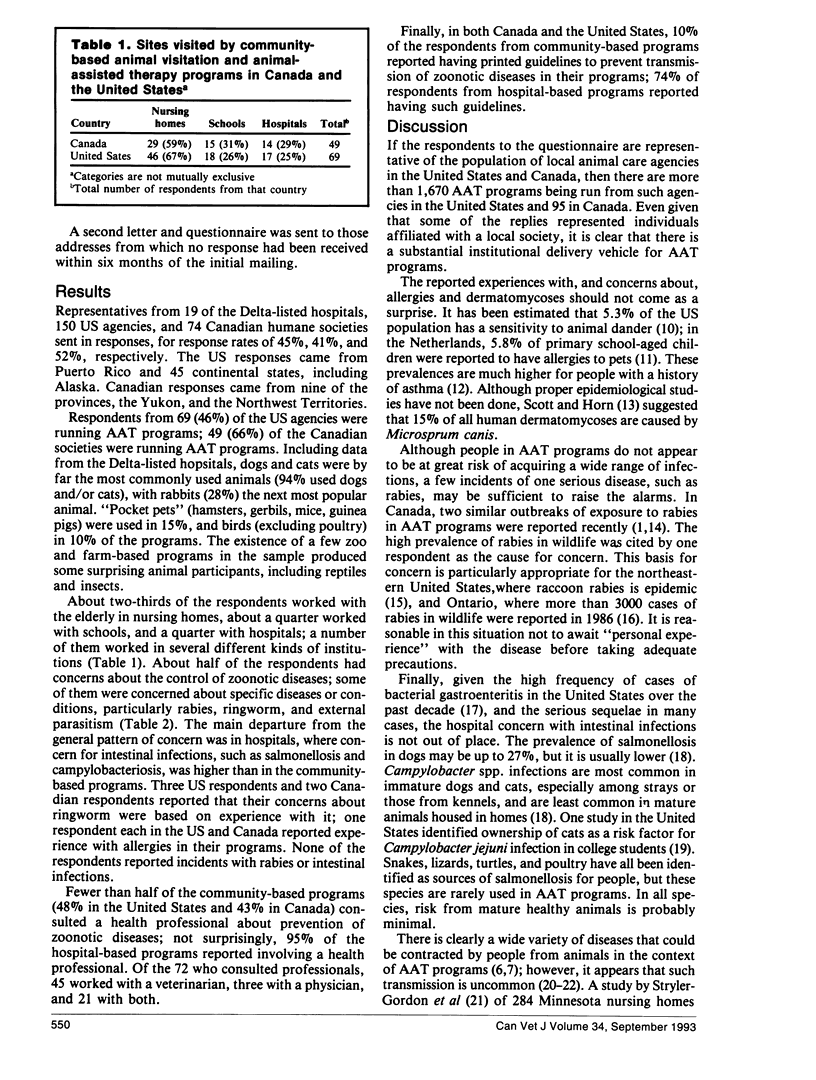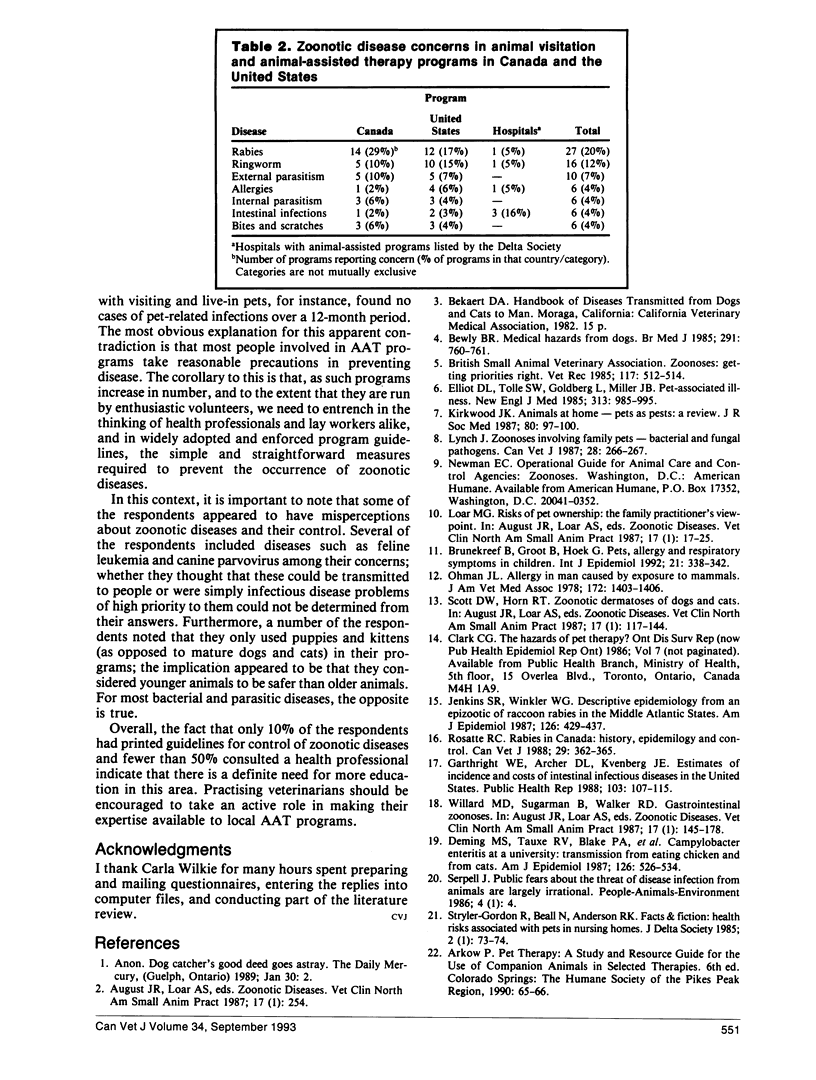Abstract
A survey was done of 150 systematically selected United States animal care agencies and 74 Canadian humane societies to determine the prevalence of animal assisted therapy (AAT) programs; concerns about, and experience with, zoonotic diseases; and precautions taken to prevent zoonotic disease transmission. Of the 69 US agencies and 49 Canadian societies that reported having AAT programs, 94% used dogs and/or cats in their programs, 28% used rabbits, 15% used “pocket pets” (hamsters, gerbils, mice, guinea pigs), and 10% used birds (excluding poultry). About two-thirds of the programs were involved with the elderly in nursing homes, about a quarter of them worked with schools, and a quarter worked with hospitals. Half of the respondents had concerns about zoonotic disease control. Rabies, ringworm, and external parasitism were the most commonly cited zoonotic diseases of concern. Few concerns were based on actual experience. Fewer than half of the programs consulted a health professional about prevention of zoonotic diseases. Only 10% of the respondents reported having printed guidelines about the prevention of zoonotic disease transmission. Practising veterinarians are encouraged to make their expertise available to local AAT programs.
Full text
PDF


Selected References
These references are in PubMed. This may not be the complete list of references from this article.
- Bewley B. R. Medical hazards from dogs. Br Med J (Clin Res Ed) 1985 Sep 21;291(6498):760–761. doi: 10.1136/bmj.291.6498.760. [DOI] [PMC free article] [PubMed] [Google Scholar]
- Brunekreef B., Groot B., Hoek G. Pets, allergy and respiratory symptoms in children. Int J Epidemiol. 1992 Apr;21(2):338–342. doi: 10.1093/ije/21.2.338. [DOI] [PubMed] [Google Scholar]
- Deming M. S., Tauxe R. V., Blake P. A., Dixon S. E., Fowler B. S., Jones T. S., Lockamy E. A., Patton C. M., Sikes R. O. Campylobacter enteritis at a university: transmission from eating chicken and from cats. Am J Epidemiol. 1987 Sep;126(3):526–534. doi: 10.1093/oxfordjournals.aje.a114685. [DOI] [PubMed] [Google Scholar]
- Elliot D. L., Tolle S. W., Goldberg L., Miller J. B. Pet-associated illness. N Engl J Med. 1985 Oct 17;313(16):985–995. doi: 10.1056/NEJM198510173131605. [DOI] [PubMed] [Google Scholar]
- Garthright W. E., Archer D. L., Kvenberg J. E. Estimates of incidence and costs of intestinal infectious diseases in the United States. Public Health Rep. 1988 Mar-Apr;103(2):107–115. [PMC free article] [PubMed] [Google Scholar]
- Jenkins S. R., Winkler W. G. Descriptive epidemiology from an epizootic of raccoon rabies in the Middle Atlantic States, 1982-1983. Am J Epidemiol. 1987 Sep;126(3):429–437. doi: 10.1093/oxfordjournals.aje.a114674. [DOI] [PubMed] [Google Scholar]
- Kirkwood J. K. Animals at home--pets as pests: a review. J R Soc Med. 1987 Feb;80(2):97–100. doi: 10.1177/014107688708000212. [DOI] [PMC free article] [PubMed] [Google Scholar]
- Lynch J. A. Zoonoses involving family pets - bacterial and fungal pathogens. Can Vet J. 1987 May;28(5):266–267. [PMC free article] [PubMed] [Google Scholar]
- Ohman J. L. Allergy in man caused by exposure to mammals. J Am Vet Med Assoc. 1978 Jun 15;172(12):1403–1406. [PubMed] [Google Scholar]
- Rosatte R. C. Rabies in Canada - history, epidemiology and control. Can Vet J. 1988 Apr;29(4):362–365. [PMC free article] [PubMed] [Google Scholar]
- Scott D. W., Horn R. T., Jr Zoonotic dermatoses of dogs and cats. Vet Clin North Am Small Anim Pract. 1987 Jan;17(1):117–144. doi: 10.1016/s0195-5616(87)50609-x. [DOI] [PubMed] [Google Scholar]
- Willard M. D., Sugarman B., Walker R. D. Gastrointestinal zoonoses. Vet Clin North Am Small Anim Pract. 1987 Jan;17(1):145–178. doi: 10.1016/s0195-5616(87)50610-6. [DOI] [PubMed] [Google Scholar]


